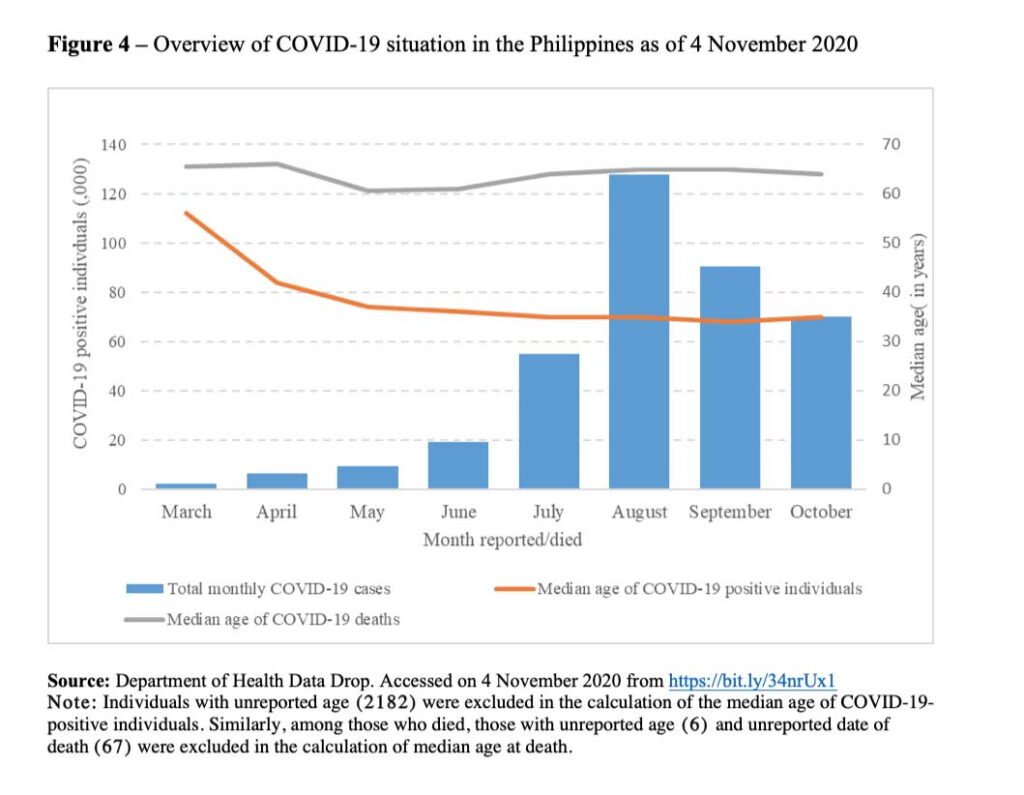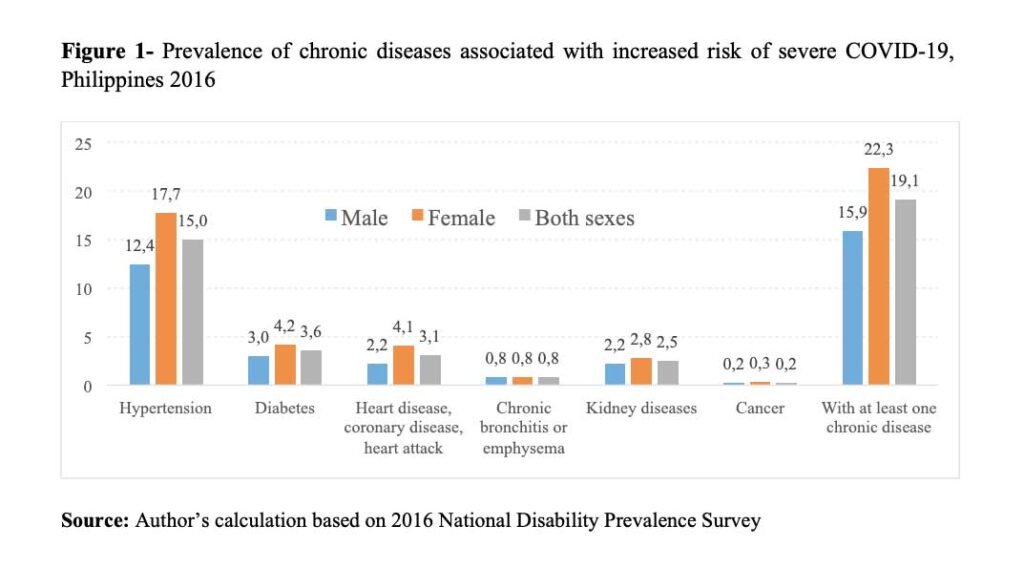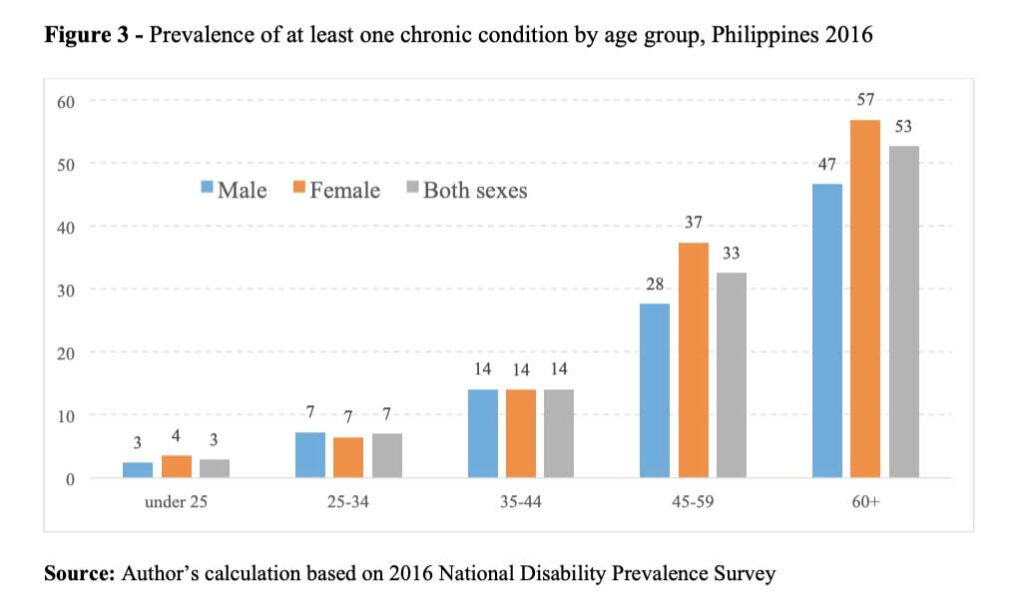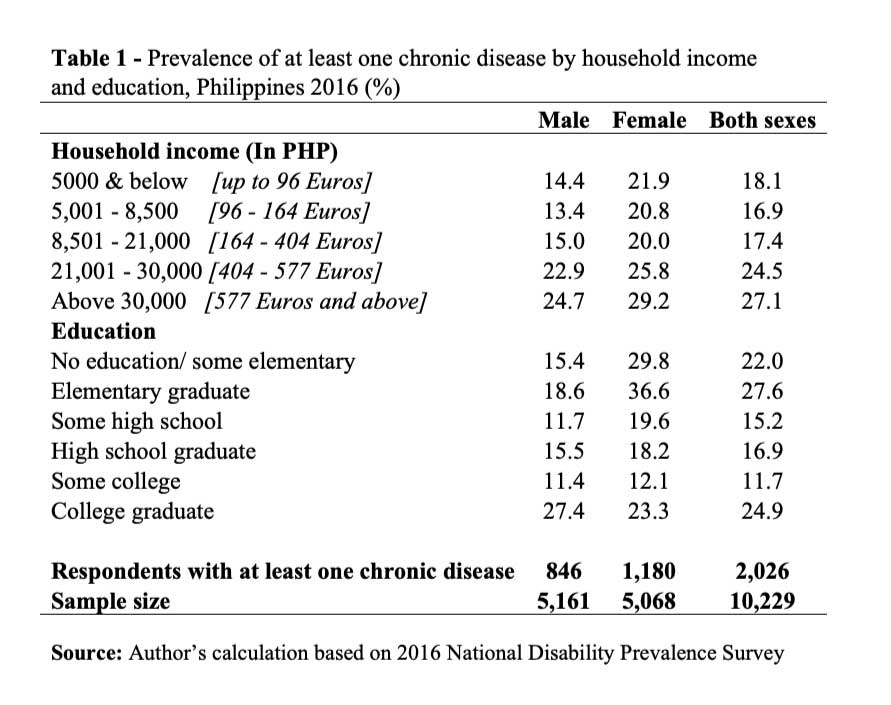The Philippines has the one of the highest numbers of COVID-19 cases in Southeast Asia. Using the 2016 National Disability Prevalence Survey, Jeofrey B. Abalos describes the prevalence of chronic diseases associated with increased risk of severe COVID-19
infections in the Philippines, and identifies the characteristics of Filipinos who have these medical conditions. Older people and those with higher socioeconomic status report higher prevalence of underlying medical conditions associated with severe COVID-19.
COVID-19 virus can infect individuals across all age groups, but the World Health Organization (WHO, 2020) has identified two groups with higher risk of severe COVID-19 disease: those who are over 60 years and those with underlying medical conditions such as cardiovascular disease, diabetes, chronic respiratory disease, and cancer (World Health Organization [WHO], 2020a). Using data from the 2016 National Disability Prevalence Survey (NDPS), this article describes the prevalence of chronic diseases associated with severe COVID-19 infections in the Philippines, and identifies the characteristics of Filipinos who have these medical conditions. The 2016 NDPS is a nationally representative survey that covers more than ten thousand respondents aged 15 years and over (PSA & DOH, 2019).
Age differences in the prevalence of selected chronic diseases
About 1 in 5 Filipinos aged 15 years and over has at least one medical condition associated with increased risk of severe COVID-19 infection. Hypertension (15%) is the most common of these chronic diseases, distantly followed by diabetes (4%) and cardiovascular diseases (3%). A slightly higher proportion of women than men have been diagnosed with these three conditions (Figure 1).
Of those diagnosed with these medical conditions, a significant share had not been treated in the 12 months preceding the 2016 survey: for example, about 16% of those with hypertension and 23% of those with kidney disease (figure 2).
The prevalence of chronic conditions associated with increased risk of severe COVID-19 is highest among Filipinos aged 60 years and over (53% have at least one). Meanwhile, about 14% of young adults (35-44) and 33% of middle-aged Filipinos (45-59) have at least one chronic disease. While there is little sex difference in prevalence at young ages, a higher proportion of women than men has been diagnosed with at least one chronic condition among those who are 45 years old and over (figure 3).
Socioeconomic differences in the prevalence of selected chronic diseases
The prevalence of chronic disease increases with household income and educational level (Table 1), but is also high among those at the lower end of the education continuum. One explanation for this relatively higher prevalence among high-income groups is their greater access to healthcare services, which facilitates early diagnosis of their medical conditions. Since educational attainment is closely related to occupation, chronic disease prevalence is also high among highly qualified occupations such as managers (26%) and professionals (23%). It is also relatively high among technicians and associate professionals (28%); craft and related trades workers (23%); and among skilled agricultural, forestry, and fishery workers (20%).
To further assess the vulnerabilities of different occupational groups to COVID-19, following Casura et al. (2020), I broadly classified them into frontline (23%) and non-front line workers (77%). Frontline workers (e.g. health workers, bank tellers, receptionists, security guards, and sales workers) are exposed to additional risks of infection because they work directly with patients, co-workers, and clients.
About 17% of frontline workers have at least one chronic disease associated with a higher risk of severe COVID-19. Given their increased vulnerability to COVID-19, which can be compounded by underlying medical conditions, frontline workers need to have adequate health care insurance. However, only about a quarter of frontline workers (26%) receive medical services or health care insurance from their employers. Overall, only 27% of Filipinos receive job-related health care insurance.
Protecting vulnerable groups amidst the pandemic
The first confirmed case of COVID-19 in the Philippines was reported on 30 January 2020 (World Health Organization [WHO], 2020b). Since then, the number of cases has steadily increased, reaching its peak in August (Figure 4). On 16 March 2020, President Duterte placed the whole of Luzon, the country’s biggest island group including Metro Manila, under enhanced community quarantine (ECQ) or total lockdown to prevent further spread of the virus. The rest of the country was later placed under varying forms of lockdown depending on the number and rate of COVID-19 infections. On 16 May 2020, the total lockdown in Metro Manila and some provinces was lifted, and was replaced with a modified enhanced community quarantine (MECQ) or partial lockdown. Since 1 June 2020, Metro Manila, where COVID- 19 cases are concentrated, has been placed under general community quarantine (GCQ) or a more relaxed lockdown. However, for about two weeks in August, Metro Manila and other provinces reverted to MECQ when health workers in the country called for a “time out” amidst the unprecedented increase in COVID-19 infections. Under GCQ, minimum public health standards, such as wearing of a face mask and physical distancing, are strictly enforced. Face-to-face or in-person classes have also been suspended during this period.

More than half of older Filipinos, and about a quarter of those aged 35-59 have been diagnosed with conditions that make COVID-19 more dangerous. This high proportion among the relatively young age groups has important public health implications, as the age structure of COVID-19 infections in the Philippines has started to shift towards the younger age groups (University of the Philippines Population Institute [UPPI] & Demographic Research and Development Foundation, 2020).
To protect vulnerable groups such as older people aged 66 years and above, and those with underlying medical conditions associated with a higher risk of severe COVID-19, the Philippine government requires this group to stay in their homes, except when obtaining essential goods or services or for work in industries or offices that have been approved to operate. This policy restricting the movement of older people has been criticized by some groups as a form of ‘ageism’ or discrimination against older Filipinos, but the government argues that the policy is intended to protect them from COVID-19.
Protecting the younger segment of the population has become more challenging recently as they have started to return to work (at least, those who still have work to return to), and are therefore more exposed to the risk of COVID-19.
To protect against COVID-19, the World Health Organization advises those with underlying medical conditions to have an adequate supply of their regular medications and ensure that their vaccinations are up to date. However, a significant proportion of Filipinos with underlying medical conditions are not receiving any medication at all. One means to protect this high-risk group would be to ramp up the provision of health care services to those with underlying medical conditions, particularly those without the means to afford these services. Provision of free healthcare insurance to employees, particularly frontline workers, would also play a protective role during this COVID-19 pandemic.
References
Casura L., Lowe R. Jr., Martinez C., Serpas S., Castellanos V., & Singelmann J. (2020). Frontline workers in the U.S.: race, ethnicity, and gender.
PSA & DOH (Philippine Statistics Authority & Department of Health) (2019). National Disability Prevalence Survey (Model Functioning Survey) 2016. Quezon City: PSA.
University of the Philippines Population Institute [UPPI] & Demographic Research and Development Foundation, I. D. (2020). The changing demographics of COVID-19 infections and deaths: how age and sex structure, living arrangement and family ties intersect.
World Health Organization [WHO]. (2020a). Coronavirus disease 2019 (COVID-19) Situation Report – 51.
World Health Organization [WHO]. (2020b). Coronavirus disease (COVID-19) in the Philippines.
Source Figure 4: bit.ly/DataDropArchives






